The Gran Chaco War: Fighting for Mirages in the Foothills of the Andes
The Gran Chaco is the most inhospitable part of the inhospitable Chaco Boreal, a largely
uninhabited, 250,000 sq-mi region west of the Paraguay River and east of the foothills of the Andes in
Paraguay, Bolivia, and Argentina. 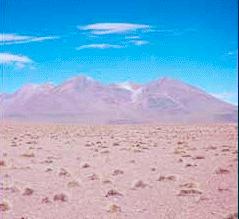 It is
an arid, semi-desert, where some of the highest temperatures recorded in South America are encountered.
In the west, near the mountains, the Gran Chaco is a flat, sparsely vegetated, waterless plain. Further
east it is a thick, dry, almost impassable thornbrush jungle punctuated by dense stands of quebracho trees
and grassy clearings. There are few people, but myriad biting, stinging insects and many tropical diseases.
Prior to 1928, the region's only real value was the tannin extracted from its quebrachos and the meager
grazing it provided for cattle. Such was the unlikely bone of contention in South America’s bloodiest,
twentieth-century war.
It is
an arid, semi-desert, where some of the highest temperatures recorded in South America are encountered.
In the west, near the mountains, the Gran Chaco is a flat, sparsely vegetated, waterless plain. Further
east it is a thick, dry, almost impassable thornbrush jungle punctuated by dense stands of quebracho trees
and grassy clearings. There are few people, but myriad biting, stinging insects and many tropical diseases.
Prior to 1928, the region's only real value was the tannin extracted from its quebrachos and the meager
grazing it provided for cattle. Such was the unlikely bone of contention in South America’s bloodiest,
twentieth-century war.
The Gran Chaco belonged originally to the same Spanish colonial district (audiencia) as Bolivia.
So it was, in Bolivian eyes, legally subject to the Spanish administration's successor government in La Paz.
But the mountain peoples of the Bolivian Altiplano, a Quecha Indian underclass and a Spanish aristocracy,
descended from Spanish conquistadores, had little real connection with the sweltering lowlands of the
Gran Chaco or with the indigenous peoples who inhabited it. Bolivians did not live in the Chaco,nor did they
exploit its meager resources. Bolivian businessmen looked into the possibility of a port on the Paraguay River,
but otherwise did little to make use of the territory, gravely compromising their claims to the area, at least
in North American and European eyes. On the other hand, the Guarani, the largely indigenous people of Paraguay,
were linked to the Chaco by culture and language. Paraguayan settlers had long since brought cattle to the region
and had established a tannin industry based on the quebracho. Paraguay had settled and improved the country.
The government had brought industrious Mennonite communities from the United States to settle in the Chaco
and had sold extensive tracts to Argentinian land developers and cattle companies. Thus, while Paraguay had
claimed the Chaco when Spanish rule collapsed in 1810, its real hold rested on de facto grounds—use
and occupation—rather than de jure title
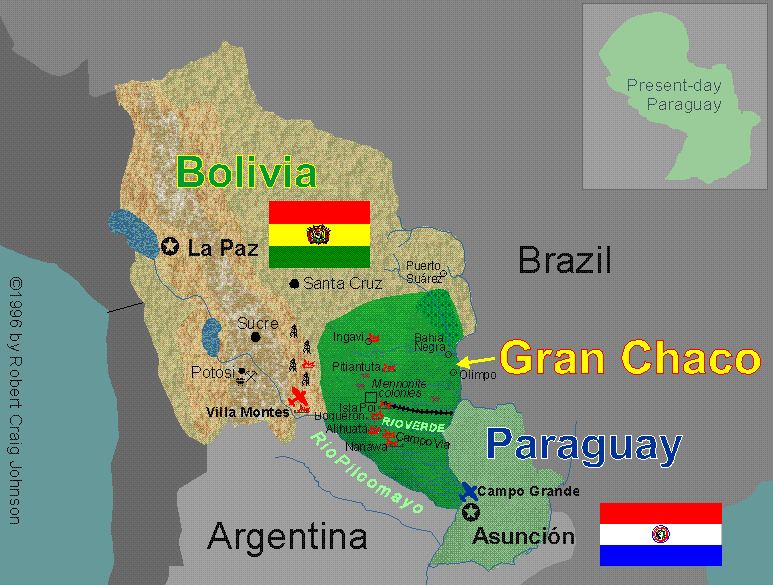
So matters might have rested. Bolivia might never have taken an interest in its one-time de jure
territory, and Paraguay might have gone on with its quiet, unofficial settlements. But in 1884, Bolivia
had lost the Pacific War and, with it her coastline, to Chile. To the nineteenth-century mind, great powers
were sea powers that could carry on trade and project power over global distances. Suddenly, Bolivia had to
either give up her aspirations to greatness or find some other outlet to the sea. The former course was
anathema to fiercely nationalistic Bolivian politicians, newspaper editors, and student agitators.
The officer corps of the defeated army likewise rejected any course that conceded the reality of
defeat. Bolivians thus turned their hopes to their remaining frontier, the Chaco Boreal and its navigable
border, the Paraguay River.
At first, both sides seemed content to press their claims by peaceful means. A series of international
arbitrations and temporary settlements brokered by Argentina, President Hayes of the United States, and
King Leopold of the Belgians kept the peace for a time. Both sides marshalled their historians and turned
over their archives for supporting documentation. Meanwhile, the status quo continued.
Then, in 1928, oil was discovered in the foothills of the Andes at the western extremity of the Chaco.
Bolivia suddenly took belated notice of its neglected territory and sought to assert its rights. The
Gran Chaco seemed on the verge of an oil boom. Further oil fields might lie beneath the Chaco's arid
plains. More importantly, Bolivian-controlled pipelines and a sovereign oil port now seemed
absolutely necessary. Without them, Argentina would have a monopoly on shipping the oil and the nation's
rightful profits would be syphoned off by foreign speculators. Paraguay reacted to this sudden onslaught from
the north with violent indignation. The Guarani saw no reason why the late-comers from the mountains
should enjoy the fruits of their labors, simply because a defunct colonial power had made a few
thoughtless marks on a map. They were in no mood for territorial concessions. At the time of its
independence from Spain in 1811, Paraguay had been one of the larger nations on the continent. But
three neighbors, Argentina, Uruguay, and Brazil, had seized more than half its territory in the War of
the Triple Alliance. The loss still rankled, and impoverished Paraguay was not prepared to let its last
hope for economic development join its other lost territories.
Fighting began in 1928, when Bolivia tried to establish an outlet to the sea via the Paraguay
River. Paraguayan troops wiped out a newly established Bolivian border fort. An exchange of
sporadic raids and skirmishes commenced. But formal warfare did not start for four more years.
The League of Nations carried on a series of desultory negotiations and arranged a truce.
When full-scale hostilities commenced in June 1932, both countries immediately faced daunting
logistical difficulties. The swamps and forests, together with the lack of roads, the harsh climate,
and the vast distances involved, made assembling and moving troops extremely difficult.
Soldiers and animal transport were ravaged by disease, ill-fed, and chronically short of materiel.
Yet the belligerents were determined to fight a proper, modern war, in so far as their means would
allow.
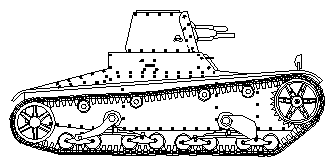 At first, Bolivia had the advantage militarily, particularly in the air. In the course of the conflict,
the Cuerpo de Aviación had about sixty combat aircraft available, including various fighters,
Curtiss bomber-reconaissance biplanes, and Junkers W.34 bomber-transports. In 1930, it used
the proceeds of its mines and a line of credit from Standard Oil of Bolivia to conclude a major
arms deal with Vickers. Bolivia acquired a number of Vickers 6-tonne tanks (right) and Carden-Lloyd Mk. VI
tankettes (machinegun carriers), 55-mm mountain artillery, Vickers machineguns, and six Vickers
Type 143 Bolivian Scouts, an export fighter for which Bolivia proved the only customer—surely one
of the shortest total production runs on record. The Scout's supercharged, 500-hp Bristol Jupiter VIA
radial engine and generous wing area gave the Scout a good high-altitude performance for its day, an
important consideration in Bolivia. It spanned 33 ft 6 in, was 26 ft 3 in long, and weighed
2246 lbs maximum at takeoff. Service ceiling was 20,000 ft and maximum speed was 150 mph.
Like all the fighters in the conflict, it was armed with a pair of rifle caliber machineguns,
.303 Vickers in this case.
At first, Bolivia had the advantage militarily, particularly in the air. In the course of the conflict,
the Cuerpo de Aviación had about sixty combat aircraft available, including various fighters,
Curtiss bomber-reconaissance biplanes, and Junkers W.34 bomber-transports. In 1930, it used
the proceeds of its mines and a line of credit from Standard Oil of Bolivia to conclude a major
arms deal with Vickers. Bolivia acquired a number of Vickers 6-tonne tanks (right) and Carden-Lloyd Mk. VI
tankettes (machinegun carriers), 55-mm mountain artillery, Vickers machineguns, and six Vickers
Type 143 Bolivian Scouts, an export fighter for which Bolivia proved the only customer—surely one
of the shortest total production runs on record. The Scout's supercharged, 500-hp Bristol Jupiter VIA
radial engine and generous wing area gave the Scout a good high-altitude performance for its day, an
important consideration in Bolivia. It spanned 33 ft 6 in, was 26 ft 3 in long, and weighed
2246 lbs maximum at takeoff. Service ceiling was 20,000 ft and maximum speed was 150 mph.
Like all the fighters in the conflict, it was armed with a pair of rifle caliber machineguns,
.303 Vickers in this case.
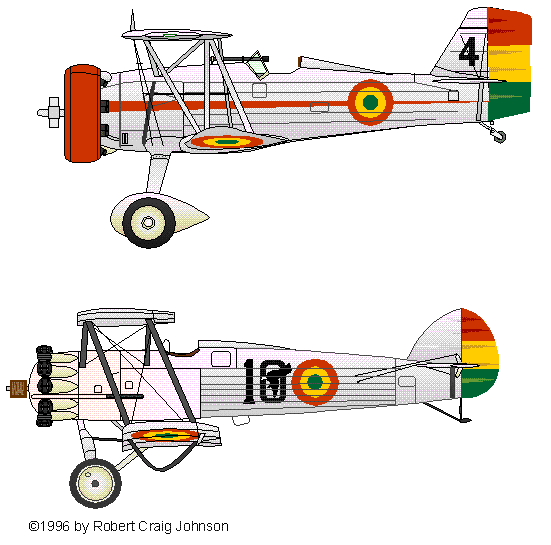 Fighters, Cuerpo de Aviación Boliviano, 1930-35: Curtiss Hawk II (top); Vickers Type 143 Bolivian Scout (bottom)
Fighters, Cuerpo de Aviación Boliviano, 1930-35: Curtiss Hawk II (top); Vickers Type 143 Bolivian Scout (bottom)
Four Curtiss P-1 Hawks were acquired in 1927 and nine Hawk IIs in 1932-33. The Hawk II was the
principle Bolivian fighter. It was essentially a land-based version of the US Navy’s BFC Goshawk.
A 600-hp Wright R-1820 gave the Hawk II a 202-mph top speed and a 25,000-ft service ceiling.
Nine Curtiss Falcon two-seat reconaissance bombers—radial-engined variants of the US Army
O-1/A-3—were added at the same time. The ground troops were meanwhile provided with organic air defense
in the form of excellent SEMAG-Becker 20-mm AA guns, two of which were supplied to a division (Bolivian
divisions were actually of regiment or batalion size).
 Bomber-Reconaissance, Cuerpo de Aviación Boliviano, Villa Montes, 1935: Curtiss Falcon
Bomber-Reconaissance, Cuerpo de Aviación Boliviano, Villa Montes, 1935: Curtiss Falcon
While Bolivia began the war with new, Vickers- and Curtiss-built equipment, impoverished Paraguay’s
armed forces were caught between procurement cycles and desperately short of cash. From 1927-1929,
the country had re-equipped its air force with a number of French-made Potez 25A.2 reconaissance
bombers and seven Wibault 73C.1 fighter monoplanes (numbered 1-7). The Potez 25 was a widely
exported two-seat biplane developed primarily as what would later be called a COIN airplane. It was
designed for use against the fractious, independence-minded natives of France’s colonies. It looked very much
like a WW1 type. While excellent for its intended purpose, it was at a definite disadvantage when facing
aerial opposition. It spanned 46 ft 4.75 in, was 29 ft 10.25 in long, and weighed 4317 lbs
(t/o). It could reach 137 mph and 23,600 ft. Range was 410 miles and bombload was 440 lbs. The
Wibault was a rarity for its time, an all-metal parasol monoplane covered with Wibault’s own
system of corrugated metal skinning. It was about 25 ft long, spanned 35 ft 11 in, and weighed
3351 lbs. Performance closely approximated that of the Potez.
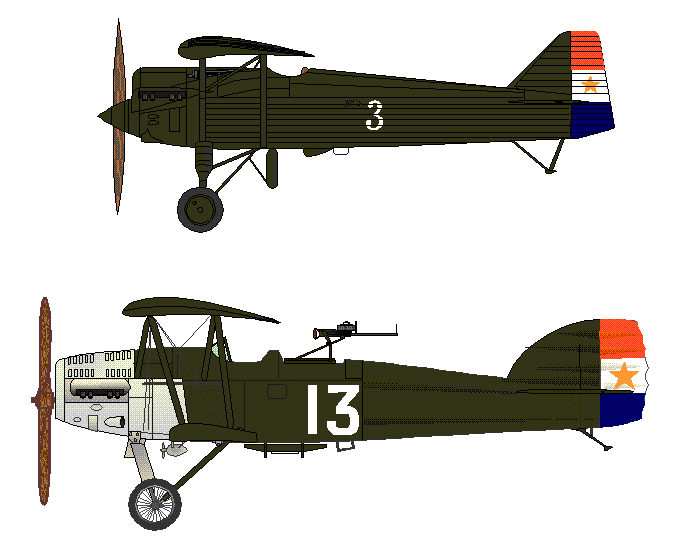 Combat aircraft, Paraguayan Air Force: (top) Wibault 73C.1 fighter,
Primera Escuadrilla de Caza, 2nd Lt. Juan Gonzales Doldan, Campo Grande, 1932; Potez 25A.2
reconaissance-bomber, 1932-35
Combat aircraft, Paraguayan Air Force: (top) Wibault 73C.1 fighter,
Primera Escuadrilla de Caza, 2nd Lt. Juan Gonzales Doldan, Campo Grande, 1932; Potez 25A.2
reconaissance-bomber, 1932-35
Unfortunately, the aircraft were already obsolescent in 1932. Worse still, Paraguay had tried to
economize by standardizing on one engine for both fighters and bombers. Unfortunately, the engine Paraguay
chose was the 450-hp Lorraine-Dietrich 12Eb. This was a water-cooled, W-12 with three banks of four
cylinders each. It was heavy and old fashioned, and its cooling system had been marginal even in
northern Europe. In the sweltering Gran Chaco, it was a disaster. So much had been spent for the
airplanes, however, that nothing could be spared for replacements. What little finance was available
had to be spent on other, more urgently needed armaments. Shortly after the start of operations,
Paraguayan mechanics found themselves frantically cannibalizing aircraft to keep a minimum number of
flying. Many were lost to forced landings and in-flight fires. Soon, serviceability was so bad that the
Wibaults had to be grounded so that the remaining engines could be reserved for the more urgently required
Potez.
The army was in somewhat better shape. During the final months prior to the outbreak of war, Paraguayan
diplomats secured a secret loan from Argentina. Unlike Bolivia, Paraguay had almost no standing
army and no peace-time budget for mobilization stockpiles. While their troops fought the first skirmishes
of the war armed with machetes and one castoff Argentine Mauser rifle for every 3-7 men, a civilian purchasing
commission frantically shopped the arms bazaars of Europe for bargain equipment.
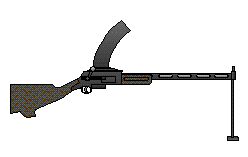 Ironically, the inexperience of the men
selected for the task and the crippling, national lack of funds now proved fortuitous. While Bolivia's
professionals spent lavishly on
"serious" weapons, like heavy Schneider howitzers, water-cooled heavy machineguns, tanks, and the all but
useless little Vickers mountain guns, the Paraguayan amateurs bought poor man's artillery—light, cheap,
Stokes-Brandt mortars, three of which could be had for the price of one field gun—and Madsen light machineguns (right).
Cartridges and artillery shells could be had clandestinely, free of charge, from the Argentine army, and
grenades were in production in Paraguay itself. In the heat, dense brush, and mud of the Chaco, lightness,
mobility, and a high trajectory were the dominant requirements. Mortars, grenades, and light automatic weapons so
dominated the battlefields that Bolivia was forced to return to Vickers for large quantities of both. Later in
the war, when Paraguay's funds were exhausted, she relied almost entirely on capturing this fresh Bolivian
materiel for her own needs.
Ironically, the inexperience of the men
selected for the task and the crippling, national lack of funds now proved fortuitous. While Bolivia's
professionals spent lavishly on
"serious" weapons, like heavy Schneider howitzers, water-cooled heavy machineguns, tanks, and the all but
useless little Vickers mountain guns, the Paraguayan amateurs bought poor man's artillery—light, cheap,
Stokes-Brandt mortars, three of which could be had for the price of one field gun—and Madsen light machineguns (right).
Cartridges and artillery shells could be had clandestinely, free of charge, from the Argentine army, and
grenades were in production in Paraguay itself. In the heat, dense brush, and mud of the Chaco, lightness,
mobility, and a high trajectory were the dominant requirements. Mortars, grenades, and light automatic weapons so
dominated the battlefields that Bolivia was forced to return to Vickers for large quantities of both. Later in
the war, when Paraguay's funds were exhausted, she relied almost entirely on capturing this fresh Bolivian
materiel for her own needs.
Mercenaries were much in evidence throughout the conflict. The chief of the Bolivian general staff and,
for a time, de facto dictator of the nation, was a German veteran of World War 1's
Eastern Front, General Hans Kundt. Chilean mercenaries and a Czech contract military mission
advised Bolivian forces in the field. Paraguay had the services of two White Russian emigrés, General Belaieff,
formerly of Wrangel's staff, and Gen. Ern. Another Russian, Vladimir Porfenenko, and one Walter Gwynn flew
fighters for Paraguay, the latter being killed. Late in the war, a large-scale Italian mission arrived to
train and equip Paraguay's exhausted forces prior to their final victory.
Paraguay, however, relied for the most part on a series of brilliant native officers for her tactical and
strategic planning, while Bolivia leaned heavily on the foreigners. Many of Paraguay's unit commanders
had gained combat experience as volunteers with the French army in World War 1. They were quick to
note the mistakes of their supposedly more advanced, more civilized European counterparts and made use
of the experience gained in the conflict that awaited them in their homeland. Paraguay's army commander,
Colonel later General later Marshal José Félix Estigarribia, epitomized the brilliance and professionalism
of this largely amateur army. He was easily the greatest soldier of the war. He capitalized
on the Guarani's knowledge of the forest and on the independence born of egalitarian Paraguayan life. He
husbanded his meager resources, avoiding the suicidal assaults on entrenched positions that characterized
the fighting on Europe's Western Front. But he also mounted audacious attacks when conditions were favorable and
frequently encircled and destroyed Bolivian forces that far outnumbered his own. Unlike his Bolivian counterparts,
he was on close terms with the civilian government and the elected president, Eusebio Ayala, throughout the war and
recognized his duty to bow before civilian wishes.
While her soldiers were excellent, the Bolivian command was uniformly awful. The native officers were
politically ambitious and frequently insubordinate. With the exception of the air force pilots, a number of
whom had flown for France, Bolivians lacked tactical sense and imagination. Kundt was, if anything, even worse.
He had been a good peacetime general, maintaining Prussian discipline in a large and well-equipped peacetime
army. He had commanded a regiment on the Russian Front. But, as Paraguay's excellent intelligence
service soon discovered, he had learned none of the lessons that produced victory at Tannenburg and in
the 1918 offensives. Instead, he repeatedly sent his men charging into frontal attacks on dug-in
enemies, without artillery preparation or the covering fire of machineguns. Flanking maneuvers were
utterly alien to his way of thinking. Aerial reconaissance was, in his opinion, worthless, because
airmen were prone to exaggeration (several disastrous encirclements were in fact spotted by Bolivian
reconaissance and reported to Kundt and his officers in good time, but the German generalissimo dismissed
the reports out of hand). The Chileans and Czechs were consummate professionals, by all accounts, but they
arrived on the scene late, at the behest of a rapidly fading civilian authority, and were not allowed to take
any major part in the war.
 Curiously, Paraguay's French-trained army
had mastered the German tactics Kundt disdained. Estigarribia invariably bypassed strongpoints and infiltrated
enemy lines, often encirling his opponents (Paraguay held over 30,000 POWs by the war's end, against 3,000 held
by Bolivia). The White Russians were hardly known for tactical brilliance or flexibility, either during the World
War or in the Civil War they so conspicuously lost. Yet Belaieff and Ern designed field fortifications with storm
troopers and infiltration in mind. They created entrenched "islands" armed with mortars, machineguns, wire, and
mines. These islands shared interlocking fields of fire designed so that infiltrators would find themselves
channeled into killing gounds. (Left: strongpoints typical of the fortins used by both sides, after a sketch by Fernandez)
Curiously, Paraguay's French-trained army
had mastered the German tactics Kundt disdained. Estigarribia invariably bypassed strongpoints and infiltrated
enemy lines, often encirling his opponents (Paraguay held over 30,000 POWs by the war's end, against 3,000 held
by Bolivia). The White Russians were hardly known for tactical brilliance or flexibility, either during the World
War or in the Civil War they so conspicuously lost. Yet Belaieff and Ern designed field fortifications with storm
troopers and infiltration in mind. They created entrenched "islands" armed with mortars, machineguns, wire, and
mines. These islands shared interlocking fields of fire designed so that infiltrators would find themselves
channeled into killing gounds. (Left: strongpoints typical of the fortins used by both sides, after a sketch by Fernandez)
The Gran Chaco conflict was, in fact, largely a war of engineers. Cutting trails through the jungle,
building roads, erecting field fortifications, and, above all, locating and drilling wells were the activities
that determined the pace and outcome of battles. The Chaco was largely without potable surface water, even
where vegetation was thickest. Before attacks could be mounted or ground held, water for men and horses had
to be brought forward by truck. Trucks and gasoline were always in such short supply that their availability
decided the timing of offensives or the feasibility of holding ground. Neither belligerent could afford to
purchase the vehicles in the requisite numbers, and wastage was high in the rough, roadless Chaco. To make
the best use of the trucks, the distance between water sources and the front had to be kept short. When it
was not, breakdowns and enemy guerilla actions could produce disaster. The Andean officers were less
conscious of this necessity than the Guarani. Many times, entire Bolivian divisions disintegrated and
surrendered en masse when encircled by inferior forces. They had outrun their water convoys, and, weakened
by dehydration and maddened by thirst, proved unable to resist the offer of even the smallest cup of water.
Bolivia's heavy investment in armor went largely for nought.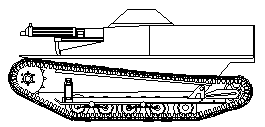 While the equipment was state of the art, it
was fundamentally ill-suited to conditions in the Chaco. It could not force passage through the scrub and
quebracho, so infantry had to go ahead to cut a path. Gasoline was scarce and urgently needed by the
trucks that brought up water and took back wounded. Since temperatures topped 100º in the shade by mid-
morning, crews had to operate with every possible hatch open. In close country, the Paraguayans quickly
found that they could easily ambush tanks and destroy them with grenades. (Right: Vickers/Carden-Lloyd Mk. VI tankette)
While the equipment was state of the art, it
was fundamentally ill-suited to conditions in the Chaco. It could not force passage through the scrub and
quebracho, so infantry had to go ahead to cut a path. Gasoline was scarce and urgently needed by the
trucks that brought up water and took back wounded. Since temperatures topped 100º in the shade by mid-
morning, crews had to operate with every possible hatch open. In close country, the Paraguayans quickly
found that they could easily ambush tanks and destroy them with grenades. (Right: Vickers/Carden-Lloyd Mk. VI tankette)
Airpower was largely misused in the Chaco War, particularly by Bolivia. Bolivia enjoyed almost total air
superiority until the last days of the conflict. But it did her little good. Her commanders
ignored aerial reconnaissance, though the information provided was usually excellent. Officers
invited losses by ordering low-level air strikes against entrenched positions that could not be
seriously harmed by the relatively light weapons the aircraft could carry. Yet they did not let
their airmen attack the long, strung-out columns of slow moving trucks and road-building infantry
that characterized the campaign. Nor did they attempt to disrupt Paraguayan traffic at the
vulnerable crossings over the Paraguay River. The Junkers trimotors were frequently called on
to drop supplies to the many encircled Bolivian units that invariably resulted from combats with
the Paraguayans. These missions were highly successful up to a point. Accurate drops were
generally made from low altitude into small positions and in the face of ground fire. But the
three or four aircraft available could never successfully supply more than a few rounds of
ammunition and a few bandages to hundreds or thousands of troops trapped without water in the
blazing Chaco sun. Paraguay's infantry dominated leadership also neglected the air arm, though
with better reason, given the low serviceability and vulnerability of the available airplanes.
Nevertheless, Paraguay achieved some success attacking Bolivian transport and using her few single
seaters for fast reconnaissance. The Potez 25 reconnaissance planes were called on for tactical
intelligence only in cases of dire need, since they were few in number and likely to be lost to
Bolivian fighters or antiaircraft guns. Paraguayan aircraft also carried out some successful
small-scale supply drops, notably at the battle of Nanawa, where Lt. Col. Luis Irrazábal's 5th
Division ran out of ammunition after flooded roads slowed road transport to a crawl. The air
drops let the Paraguayans beat off Bolivian assaults until reinforcements could arrive and
counterattack. Bolivia lost 2000 killed in the attack against 248 Guarani defenders.
Air combat was a relative rarity over the Chaco. Reconnaissance and close support for the infantry held a higher priority for both sides than did air-superiority and counter-air missions. Moreover, given the distances and the small numbers of aircraft involved on each side, pilots had a hard time finding one another. Paraguay began the war flying from its main base at Campo Grande, near the capital, Asunción, while Columbian aircraft operated out of Villa Montes, almost 400 miles away in extreme southern Bolivia. Paraguay's air force fought the Battle of Boqueron (9-29 September 1932) from advanced air fields at Isla Taguato and Isla Poi, but deployed a total of only three Wibault fighters and five Potez 25s, few of which were airworthy at any one time. On 30 September 1932, a Wibault gained the dubious distinction of being the first aircraft destroyed by air-to-air combat in South America. It crashed and was written off during landing after a fight with a Vickers 143. Fighters flew frequent escort missions for reconnaissance and bombing aircraft as well as independent armed reconnaissances of their own. By 1935, both sides had lost about 30 aircraft of all types. There were no real aces, but the Bolivian Maj. Rafael Pavon became widely known for his three victories.
By 1933, the air situation began to change. Doubtless through the good offices of Argentina, Paraguay secured the help of an Italian military training mission and Italian armaments. Italian tactical precepts and reliable, high-performance aircraft soon turned the small Paraguayan air arm into a force that could more than hold its own against the Andeans. The fighter force was re-equipped with five of the excellent FIAT CR.20bis, an agile biplane powered by a reliable, 425-hp FIAT A.20AQ water-cooled V-12. Bergamaschi AP.1 attack monoplanes and Caproni Ca.101 bomber-transports rounded out the force.
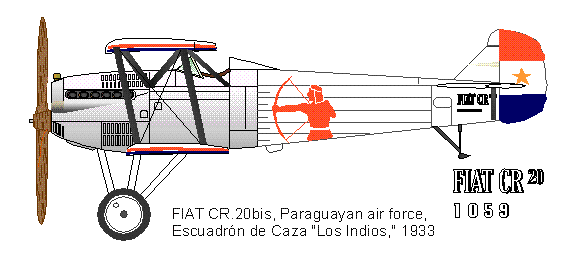
The Italians also provided Paraguay with several examples of Ansaldo's new CV33 tankette.
This was a small machinegun carrier developed from the Carden Lloyd, but incorporating better
armor protection and a marginally roomier fighting compartment. The Italians expected great
things from these vehicles. 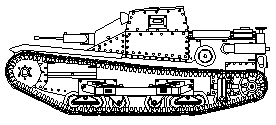 Tankettes would, they hoped, replace the unprotected foot soldier in the new mechanized
divisions of the future. In the Chaco, however, the CV33s seem to have seen little service.
The CV33 suffered from the same limitations as the Bolivian tanks. It would have been cramped
and insufferably hot in action, and would thus have been vulnerable. Guarani infantry put
little faith in armor after their own tank-hunting exploits. The CV33 had a short range,
moreover, and competed for modest gasoline supplies that were needed by the indispensable
trucks.
Tankettes would, they hoped, replace the unprotected foot soldier in the new mechanized
divisions of the future. In the Chaco, however, the CV33s seem to have seen little service.
The CV33 suffered from the same limitations as the Bolivian tanks. It would have been cramped
and insufferably hot in action, and would thus have been vulnerable. Guarani infantry put
little faith in armor after their own tank-hunting exploits. The CV33 had a short range,
moreover, and competed for modest gasoline supplies that were needed by the indispensable
trucks.
Paraguay won almost all the battles of the Chaco War, often by encircling numerical and
materially superior Bolivian units. Superior leadership and better familiarity with the country
proved decisive. Paraguay's army was, in fact, limited only by her relative poverty and consequent
lack of materiel. After 1932, almost all her trucks, artillery, machineguns, and small arms were
obtained from captured Bolivian stocks. Paraguay's armies finished up outside the Bolivian
fortess of Villa Montes, astride Bolivia's oil fields. By 1935, she had conquered all of the
disputed territory in the Gran Chaco.
On both sides, war fever was still high in some quarters. Some Guarani politicians now demanded revenge, compensation, or a "victor's peace" that would enrich their now desperately poor republic. They wanted to carry the war into Bolivia, severing the oil fields and the fertile lowland province of Santa Cruz from the Altiplano. Bolivia was equally bellicose. Her inept generals had by now forestalled criticism by overthrowing the constitutional government and imposing their own president on the nation. They proclaimed themselves willing to raise yet a third army to replace the two they had squandered and began yet another round of arms purchases. The war seemed likely to go on indefinitely.
But appearances were deceptive. Both countries were exhausted and on the verge of collapse. There were 80,000-100,000 dead. Paraguay held 300,000 prisoners, all of whom had to be fed, clothed, and housed at her expense. The familiar forests lay behind her army, the Bolivian mountains ahead. Paraguay was, moreover, too underpopulated and too poor to sustain even "moderate" human losses. She was a farming nation and needed her men at home. Bolivia had seemingly inexhaustible manpower, but her generals knew that this would not win the war, whatever they might say in public. Kundt's career had been ruined by defeat, and the civilian president had been overthrown, leaving a power vacuum at the nation's head. None of Bolivia's ambitious and politicized military chieftains wanted to be far from the capital in such times. By now, moreover, the nation's mineral wealth was mortgaged to the hilt, her costly arms were mostly lost, and morale in the army rank and file was so bad that even the stoical Quecha levies could not be relied on. Both sides needed peace.
A ceasefire negotiated in June 1935 led eventually to the signing of the Chaco Treaty in
Buenos Aires in 1938. Both sides agreed to submit their claims to binding arbitration.
The arbitrators, drawn from the ambassadors of other South American republics, granted Paraguay
by far the largest piece of the disputed territory. She kept all of the Chaco, surrendering
only mountain foothills that were geographically and historically Bolivian. Bolivia got
only a narrow corridor to the river and a useless, swampy, purely symbolic "port" far up the
Rio Paraguay. She was allowed railroad and port privileges in Paraguay, but these had been
freely offered by Paraguay prewar.
Neither the victors nor the defeated did well out of the war. In 1936, Paraguay's able
Liberal Party government, President Ayala, and the heroic Marshall Estigarribia were deposed
in a military coup staged by rear echelon hard-liners outraged at the supposedly easy terms
granted Bolivia. Paraguay succumbed to economic crisis and a series of coups and dictatorships
culminating in Gen. Stroessner's police state, which lasted from 1954 to 1988. For a time,
Bolivia's myriad colonels nervously husbanded their battalions and eyed their rivals in
anticipation of the coup they knew must come. In May of 1936, less than two weeks prior
to scheduled elections, the operationally inept Col. Ruilova Toro's leftwing faction siezed
power, overthrowing the nominal president, Sorzano Tejada, and defeating the rightest forces
of the only Bolivian officer to distinguish himself in combat, Col. Bilbao Rioja. "The command
responsible for the loss of the Chaco has received," it was said, "the government for its
reward."
And the oil? In a final irony, the petroleum wealth that had inflamed the imaginations of prewar
nationalist agitators turned out to be a will-o'-the-wisp. There was no oil in the Chaco
itself, and Bolivia's modest output was exported, not by river, but by pipeline through Brazil.
The oil speculators pronounced themselves mistaken, and left the Gran Chaco to the cow, the
quebracho, and the dead.
Notes for the modeller. The Curtiss Hawk II could be built from Lindberg's now
rather elderly 1/48-scale Goshawk kit or converted (with substantially more work) from the
1/72-scale MPM Hawk III or 1/32-scale Hasegawa BFC-2. The Wibault fighter and the Potez 25
may be available in the Heller line or in one of its eastern European reincarnations.
Armor modelers could produce the Vickers 6-tonne tank and the Carden-Lloyd tankette by modifying
any of a number of Eastern European kits covering the Polish 7TP and the Russian T-26 and T-27.
Bolivian combat aircraft were silver-doped overall with decorative trim in Bolivian national
colors. The French-built Paraguayan airplanes were camouflaged dark green overall, reportedly in
a shade close to FS34079.
Sources
Fernandez, Col. Carlos José. La Guerra del Chaco. Vol. I: Boquerón.
Buenos Aires, 1956.
Mason, Francis K. War in the Air. New York: Crescent, 1985. 25.
Sapienza, Antonio Luis. "Les Wibault 73C.1 paraguayens et brésiliens." Avions 40
(Juillet 1996):15-18.
Thompson, R. W. An Echo of Trumpets. London: George Allen and Unwin, 1964. 27-64.
Zook, David H. The Conduct of the Chaco War. New Haven, CT: Bookman, 1960.
Next page
Return to Table of Contents
© 1996 by Robert Craig Johnson. Part of a series first published, in abbreviated form, in Eagle Droppings, the Newsletter of the Rocky Mountain Chapter, IPMS/USA.
 It is
an arid, semi-desert, where some of the highest temperatures recorded in South America are encountered.
In the west, near the mountains, the Gran Chaco is a flat, sparsely vegetated, waterless plain. Further
east it is a thick, dry, almost impassable thornbrush jungle punctuated by dense stands of quebracho trees
and grassy clearings. There are few people, but myriad biting, stinging insects and many tropical diseases.
Prior to 1928, the region's only real value was the tannin extracted from its quebrachos and the meager
grazing it provided for cattle. Such was the unlikely bone of contention in South America’s bloodiest,
twentieth-century war.
It is
an arid, semi-desert, where some of the highest temperatures recorded in South America are encountered.
In the west, near the mountains, the Gran Chaco is a flat, sparsely vegetated, waterless plain. Further
east it is a thick, dry, almost impassable thornbrush jungle punctuated by dense stands of quebracho trees
and grassy clearings. There are few people, but myriad biting, stinging insects and many tropical diseases.
Prior to 1928, the region's only real value was the tannin extracted from its quebrachos and the meager
grazing it provided for cattle. Such was the unlikely bone of contention in South America’s bloodiest,
twentieth-century war.
 At first, Bolivia had the advantage militarily, particularly in the air. In the course of the conflict,
the Cuerpo de Aviación had about sixty combat aircraft available, including various fighters,
Curtiss bomber-reconaissance biplanes, and Junkers W.34 bomber-transports. In 1930, it used
the proceeds of its mines and a line of credit from Standard Oil of Bolivia to conclude a major
arms deal with Vickers. Bolivia acquired a number of Vickers 6-tonne tanks (right) and Carden-Lloyd Mk. VI
tankettes (machinegun carriers), 55-mm mountain artillery, Vickers machineguns, and six Vickers
Type 143 Bolivian Scouts, an export fighter for which Bolivia proved the only customer—surely one
of the shortest total production runs on record. The Scout's supercharged, 500-hp Bristol Jupiter VIA
radial engine and generous wing area gave the Scout a good high-altitude performance for its day, an
important consideration in Bolivia. It spanned 33 ft 6 in, was 26 ft 3 in long, and weighed
2246 lbs maximum at takeoff. Service ceiling was 20,000 ft and maximum speed was 150 mph.
Like all the fighters in the conflict, it was armed with a pair of rifle caliber machineguns,
.303 Vickers in this case.
At first, Bolivia had the advantage militarily, particularly in the air. In the course of the conflict,
the Cuerpo de Aviación had about sixty combat aircraft available, including various fighters,
Curtiss bomber-reconaissance biplanes, and Junkers W.34 bomber-transports. In 1930, it used
the proceeds of its mines and a line of credit from Standard Oil of Bolivia to conclude a major
arms deal with Vickers. Bolivia acquired a number of Vickers 6-tonne tanks (right) and Carden-Lloyd Mk. VI
tankettes (machinegun carriers), 55-mm mountain artillery, Vickers machineguns, and six Vickers
Type 143 Bolivian Scouts, an export fighter for which Bolivia proved the only customer—surely one
of the shortest total production runs on record. The Scout's supercharged, 500-hp Bristol Jupiter VIA
radial engine and generous wing area gave the Scout a good high-altitude performance for its day, an
important consideration in Bolivia. It spanned 33 ft 6 in, was 26 ft 3 in long, and weighed
2246 lbs maximum at takeoff. Service ceiling was 20,000 ft and maximum speed was 150 mph.
Like all the fighters in the conflict, it was armed with a pair of rifle caliber machineguns,
.303 Vickers in this case. 


 Ironically, the inexperience of the men
selected for the task and the crippling, national lack of funds now proved fortuitous. While Bolivia's
professionals spent lavishly on
"serious" weapons, like heavy Schneider howitzers, water-cooled heavy machineguns, tanks, and the all but
useless little Vickers mountain guns, the Paraguayan amateurs bought poor man's artillery—light, cheap,
Stokes-Brandt mortars, three of which could be had for the price of one field gun—and Madsen light machineguns (right).
Cartridges and artillery shells could be had clandestinely, free of charge, from the Argentine army, and
grenades were in production in Paraguay itself. In the heat, dense brush, and mud of the Chaco, lightness,
mobility, and a high trajectory were the dominant requirements. Mortars, grenades, and light automatic weapons so
dominated the battlefields that Bolivia was forced to return to Vickers for large quantities of both. Later in
the war, when Paraguay's funds were exhausted, she relied almost entirely on capturing this fresh Bolivian
materiel for her own needs.
Ironically, the inexperience of the men
selected for the task and the crippling, national lack of funds now proved fortuitous. While Bolivia's
professionals spent lavishly on
"serious" weapons, like heavy Schneider howitzers, water-cooled heavy machineguns, tanks, and the all but
useless little Vickers mountain guns, the Paraguayan amateurs bought poor man's artillery—light, cheap,
Stokes-Brandt mortars, three of which could be had for the price of one field gun—and Madsen light machineguns (right).
Cartridges and artillery shells could be had clandestinely, free of charge, from the Argentine army, and
grenades were in production in Paraguay itself. In the heat, dense brush, and mud of the Chaco, lightness,
mobility, and a high trajectory were the dominant requirements. Mortars, grenades, and light automatic weapons so
dominated the battlefields that Bolivia was forced to return to Vickers for large quantities of both. Later in
the war, when Paraguay's funds were exhausted, she relied almost entirely on capturing this fresh Bolivian
materiel for her own needs.  Curiously, Paraguay's French-trained army
had mastered the German tactics Kundt disdained. Estigarribia invariably bypassed strongpoints and infiltrated
enemy lines, often encirling his opponents (Paraguay held over 30,000 POWs by the war's end, against 3,000 held
by Bolivia). The White Russians were hardly known for tactical brilliance or flexibility, either during the World
War or in the Civil War they so conspicuously lost. Yet Belaieff and Ern designed field fortifications with storm
troopers and infiltration in mind. They created entrenched "islands" armed with mortars, machineguns, wire, and
mines. These islands shared interlocking fields of fire designed so that infiltrators would find themselves
channeled into killing gounds. (Left: strongpoints typical of the fortins used by both sides, after a sketch by Fernandez)
Curiously, Paraguay's French-trained army
had mastered the German tactics Kundt disdained. Estigarribia invariably bypassed strongpoints and infiltrated
enemy lines, often encirling his opponents (Paraguay held over 30,000 POWs by the war's end, against 3,000 held
by Bolivia). The White Russians were hardly known for tactical brilliance or flexibility, either during the World
War or in the Civil War they so conspicuously lost. Yet Belaieff and Ern designed field fortifications with storm
troopers and infiltration in mind. They created entrenched "islands" armed with mortars, machineguns, wire, and
mines. These islands shared interlocking fields of fire designed so that infiltrators would find themselves
channeled into killing gounds. (Left: strongpoints typical of the fortins used by both sides, after a sketch by Fernandez) While the equipment was state of the art, it
was fundamentally ill-suited to conditions in the Chaco. It could not force passage through the scrub and
quebracho, so infantry had to go ahead to cut a path. Gasoline was scarce and urgently needed by the
trucks that brought up water and took back wounded. Since temperatures topped 100º in the shade by mid-
morning, crews had to operate with every possible hatch open. In close country, the Paraguayans quickly
found that they could easily ambush tanks and destroy them with grenades. (Right: Vickers/Carden-Lloyd Mk. VI tankette)
While the equipment was state of the art, it
was fundamentally ill-suited to conditions in the Chaco. It could not force passage through the scrub and
quebracho, so infantry had to go ahead to cut a path. Gasoline was scarce and urgently needed by the
trucks that brought up water and took back wounded. Since temperatures topped 100º in the shade by mid-
morning, crews had to operate with every possible hatch open. In close country, the Paraguayans quickly
found that they could easily ambush tanks and destroy them with grenades. (Right: Vickers/Carden-Lloyd Mk. VI tankette) 
 Tankettes would, they hoped, replace the unprotected foot soldier in the new mechanized
divisions of the future. In the Chaco, however, the CV33s seem to have seen little service.
The CV33 suffered from the same limitations as the Bolivian tanks. It would have been cramped
and insufferably hot in action, and would thus have been vulnerable. Guarani infantry put
little faith in armor after their own tank-hunting exploits. The CV33 had a short range,
moreover, and competed for modest gasoline supplies that were needed by the indispensable
trucks.
Tankettes would, they hoped, replace the unprotected foot soldier in the new mechanized
divisions of the future. In the Chaco, however, the CV33s seem to have seen little service.
The CV33 suffered from the same limitations as the Bolivian tanks. It would have been cramped
and insufferably hot in action, and would thus have been vulnerable. Guarani infantry put
little faith in armor after their own tank-hunting exploits. The CV33 had a short range,
moreover, and competed for modest gasoline supplies that were needed by the indispensable
trucks.